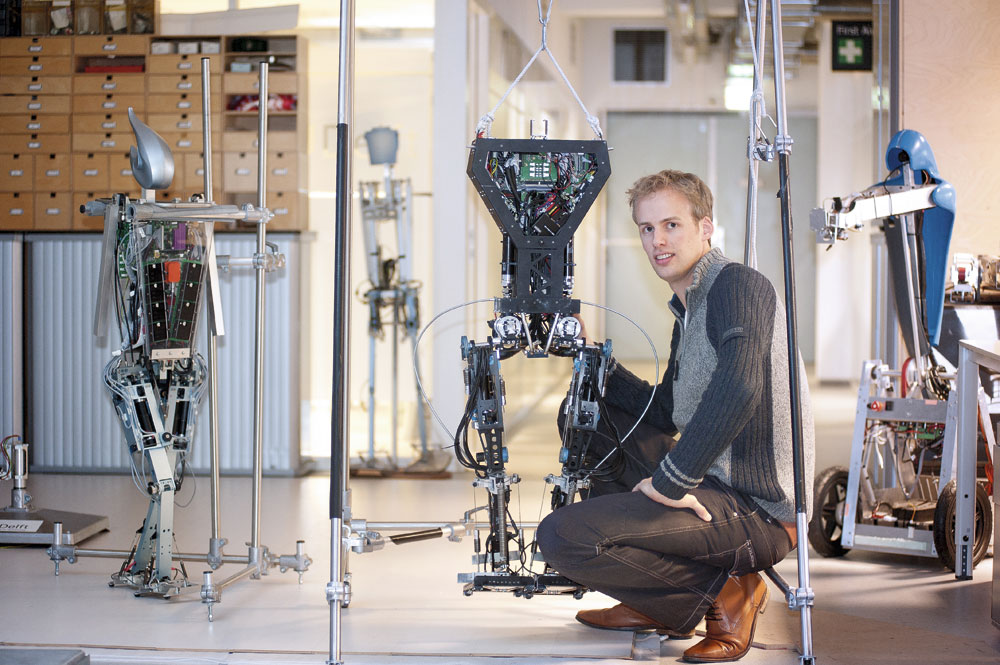A robot that you can push around and won’t fall over. This is what Dr Tomas de Boer developed for his thesis, ‘Foot placement in robotic bipedal locomotion’, which he defended this week.
She walked very smoothly, especially for a robot. Flame, which was developed several years ago at the 3mE faculty, was a hit in robotics. But when you gave her a little push, she would drop to the ground instantly. She now shares the robotics laboratory with an (in many ways) improved version of herself, Tulip, an android that can be pushed around but won’t fall over.
Mechanical engineer, Dr Tomas de Boer, developed Tulip during his PhD research. He first had a good look at how we humans keep our equilibrium, and to explain what our most important trick is, a trick which he copied in Tulip, he takes hold of a broom stick and starts balancing it upside down on his fingertip.
“Bipedal locomotion is in essence about the ability to maintain control over the position and velocity of the body’s center of mass,” De Boer explains. “When slightly perturbed, balance is quickly lost and a step must be taken to prevent a fall.” With the broom stick, one must move ones finger to continuously keep it right under the body’s center of mass.
A simple model, which De Boer call’s the broom model, and a bunch of springs in the joints of the robot, that measure all the forces at play, allow Tulip to calculate where it should put its next step and how much force it should exert on each foot in order to remain balanced.
De Boer believes balanced bipedal robots have a bright future. “They’re much more practical than robots on wheels, which can only be used on flat terrains. One can imagine bipedal robots being used as aids during rescue missions in the future, or as butlers.” As a matter of fact the researcher is now working for a company called Pal Robotics, based in Spain, which develops robotics butlers.
But some hurdles still need to be cleared, De Boer says: “It’s is still very difficult to make robots that are at the same time light, powerful and energy efficient. We buy a lot of parts from the automotive industry. There’s no real robot industry yet, but it’s coming.”
Watch Tulip as she prepares for Robocup 2011 in Istanbul.
www.dutchrobotics.net
Tomas de Boer, ‘Foot placement in robotic bipedal locomotion’, 13 March, PhD supervisor Prof. Frans van der Helm.
Tussen 1999 en 2003 stond Nederland op de achtste plaats van landen met de meeste citaten per wetenschappelijk artikel. Citaten zijn een maatstaf voor het belang dat wetenschappers aan een bepaald onderzoek hechten: hoe belangrijker zij een artikel vinden, hoe vaker ze het aanhalen. Nederland was in die jaren goed voor 2,6 procent van alle citaten wereldwijd, aldus een rapport van de Britse Royal Society.
Maar tussen 2004 en 2008 is China de top tien binnengedrongen. Op de Verenigde Staten na publiceert geen enkel land zoveel wetenschappelijke artikelen als China. De kwaliteit houdt vooralsnog geen gelijke tred, maar China sleept 3,7 procent van alle citaten binnen en heeft zodoende de zevende plaats veroverd in de ranglijst van internationale wetenschappelijke impact. De Nederlandse impact groeide intussen met een tiende procentpunt tot 2,7 procent van alle citaten, maar dat was niet genoeg om China voor te blijven.
De opmars van China (en andere Aziatische landen buiten de top tien) gaat vooral ten koste van de Verenigde Staten. Dat land staat nog altijd stijf bovenaan, maar ging van 38,6 naar 30,4 procent van alle citaties. Ook de andere toplanden, waaronder Groot-Brittannië, Duitsland en Japan, verloren terrein.
Tegelijkertijd is de wetenschap steeds meer een internationale aangelegenheid geworden. Tegenwoordig wordt meer dan 35 procent van alle artikelen geschreven door auteurs die internationaal samenwerken. In 1996 was dat nog maar 25 procent. Daar is een goede reden voor: hoe meer nationaliteiten, hoe meer citaten een artikel oplevert.
In Nederland wordt tegenwoordig meer dan de helft van alle wetenschappelijke artikelen geschreven in samenwerking met een buitenlandse auteur. Vijftien jaar geleden was dat nog maar in een derde van de artikelen het geval.



Comments are closed.